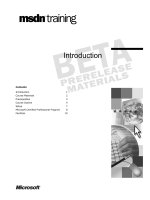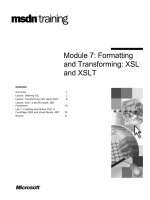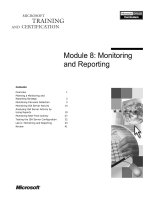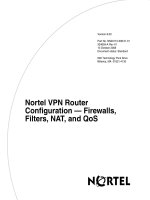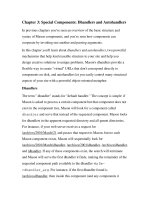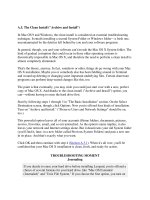Traffic Report: Online Piracy and Counterfeiting pdf
Bạn đang xem bản rút gọn của tài liệu. Xem và tải ngay bản đầy đủ của tài liệu tại đây (787.29 KB, 10 trang )
Traffic Report: Online Piracy and Counterfeiting
January 2011
2
Traffic Report: Online Piracy and Counterfeiting
Contents
Key Findings 4
Methodology 4
Criteria for Websites 5
Traffic Analysis 7
Conclusion 8
Traffic Report: Online Piracy and Counterfeiting
3
The Internet is arguably one of the greatest innovations of modern society—
allowing for countless new businesses to thrive and dramatically altering the
way society operates. The Internet has enabled a global marketplace to flourish
with lightning-quick communication and an unparalleled access to information.
However, the advancement of the Internet into nearly all of our daily activities,
combined with rapid download speeds, the perfection of digital copies, the rise
of e-commerce and the complexity of online enforcement, has magnified the
seriousness and consequences of online counterfeiting and piracy. Websites
offering pirated goods generate billions of visits annually, and websites that sell
counterfeit luxury goods, fake drugs, and products that may pose health and
safety risks attract hundreds of millions annually.
Recognizing that illicit online sales have a significant impact on the U.S. economy
in financial terms as well as in public health and well-being, MarkMonitor
®
worked
to identify a sample of rogue Internet sites that are responsible for trafficking
counterfeit and pirated goods. The goal of the project was to illustrate the nature of
this illicit ecosystem and, using publicly-available traffic information on the number
of visits, determine its scope.
The first step was to identify business categories and brands targeted by online
counterfeiters and digital pirates. Using 22 major brands as criteria—ranging from
pharmaceuticals, luxury goods, and apparel to entertainment titles and software—
MarkMonitor used its patented technology to comb the Internet for sites suspected
of offering counterfeit goods or pirated digital content. The initial scans resulted in
more than 10,000 results which were then de-duplicated and filtered further using
MarkMonitor technology to identify dedicated e-commerce and digital download
sites. The final step required hand-examination and verification of more than 600
results to determine classification. Since some sites offered multiple brands, this
step led to almost 100 unique domains or websites which were then classified in
one of two ways: ‘counterfeit’ or ‘digital piracy’.
Using publicly-available Internet traffic data from Alexa, the sites were then ranked
by the number of visits, which were significant, speaking to the level of demand for
these goods as well as to the website operators’ success in promoting these sites
so they are visible and accessible online. Since the study used a sample of only
22 brands, it provides a small glimpse of the nature of online intellectual property
(IP) theft and the dark side of illicit e-commerce. However, given the large number
of popular brands, it is reasonable to assume that hundreds of thousands of other
rights-holders, brands and content creators are suffering the same damage.
As our economy
has worsened,
brand abusers have
sharpened their focus.
Traffic Report: Online Piracy and Counterfeiting
4
Key Findings
The study’s findings demonstrate that online distribution of pirated digital content
and e-commerce sales of counterfeit goods is rampant. Specific findings include:
•
In total, the 10 media brands in the study yielded 43 unique sites classified as
‘digital piracy.’ Traffic generated to these sites was over 146 million visits per day,
representing more than 53 billion visits per year.
•
The top-three websites classified as ‘digital piracy’—rapidshare.com, megavideo.com,
and megaupload.com—collectively generate more than 21 billion visits per year.
•
The availability of reliable infrastructure is an important factor in the location of sites
hosting piracy. The study found that North America and Western Europe repre-
sented the host location for 67 percent of the sites classified as ‘digital piracy.’
•
The combined traffic to the 48 sites selling counterfeit goods is more than
240,000 visits per day on average or more than 87 million visits per year.
• When it comes to host location of the sites categorized as ‘counterfeit’, 73
percent were hosted in North America or Western Europe. Eastern European
countries hosted another 14 percent of the sites while 9 percent of the sites were
hosted in Asia.
•
The combined traffic to the 26 sites selling counterfeit prescription drugs is more
than 141,000 visits per day on average or more than 51 million visits per year.
• The combined traffic to the 21 e-commerce sites selling counterfeit luxury goods
is more than 98,000 visits per day on average or almost 36 million visits per year.
These findings are just the tip of the iceberg. The true scope of the problem is
exponentially higher in terms of user traffic, lost revenue and risks to public health
and safety.
Methodology
Using a list of industries most affected by online counterfeiting and digital piracy,
1
MarkMonitor chose major brands from each industry and ran automated scans for
those brands using its patented technology. In all, the study examined 22 brands in
the digital content category (movies/TV shows, music and software/videogames)
and the physical goods category (handbags, sports apparel, pharmaceuticals and
luxury items, footwear, and apparel.)
The study used very narrow criteria to classify sites selling physical goods as
‘counterfeit.’ It is important to point out that many of the e-commerce sites that did
not meet that strict guideline did display multiple factors arousing suspicion. This
1
Digital Content industries: Entertainment (music/movies/television shows), Software/Videogames; Physical
Goods: Handbags, Sports Apparel with logos, Pharmaceuticals, luxury items, footwear, and apparel.
The study used only
22 brands, so we can
assume that many other
brands and content-
creators are suffering
similar damage.
Traffic Report: Online Piracy and Counterfeiting
5
underscores the crucial role that brand owners
and law enforcement personnel trained by brand
owners play in determining whether a site is
offering counterfeit goods. Technology can be
used to conduct the heavy lifting in identifying
and prioritizing sites for further action, but the
in-depth market and product knowledge of brand
owners’ is vital.
The scans focused on identifying e-commerce
and peer-to-peer, streaming, and torrent sites that
yielded high traffic levels. In order to be classified
as an e-commerce site, the site needed to
contain a shopping cart while the sites classified
as piracy needed to contain some type of link,
index or player that could be used to download,
stream or share digital content. These criteria
were designed to eliminate editorial, blog or
discussion sites and to focus exclusively on sites
where pirated goods could be shared, viewed,
streamed or downloaded and counterfeit goods could be purchased.
The initial scans resulted in more than 10,000 results which were then de-
duplicated and filtered further using MarkMonitor technology to identify dedicated
e-commerce and digital content sites used for downloading, sharing or streaming.
The final step required hand-examination and verification of more than 600 results
to determine classification. Since some sites offered multiple brands, this step led
to almost 100 unique domains or websites which were then classified as either
‘counterfeit’ or ‘digital piracy’. The results were ranked by the amount of traffic,
defined as the number of daily visits, using Alexa-supplied information. None of the
scans contained MarkMonitor customer data or information.
Criteria for Websites
The results from the initial scans were examined further by MarkMonitor experts in
order to classify these sites, or domains, into one of two categories: ‘counterfeit’
or ‘digital piracy.’ After thorough analysis, MarkMonitor concluded that 91 websites
with high traffic numbers qualified for inclusion in one of these categories. The
‘counterfeit’ classification referred to e-commerce sites selling counterfeit physical
goods while the ‘digital piracy’ classification refers to sites offering pirated versions
of music, movies, television shows, software, and videogames.
Digital Piracy: The total number of unique domains identified as ‘digital piracy’
totaled 43. To fit the ‘digital piracy’ classification, the domain needed to offer
or point to one or more of the brands used in the digital content portion of the
study for free. While some of these sites do offer takedown processes for pirated
Site attracts more than 10 million visits per day.
Traffic Report: Online Piracy and Counterfeiting
6
content, the action must be initiated by the
content owner. The resulting domains were
then sorted by traffic volume.
‘Counterfeit’: In the case of e-commerce
domains selling physical goods, the domains
needed to satisfy one of two conditions to be
deemed as selling counterfeit goods: (1) either
the domain itself specified that the goods were
not authentic (i.e., using terms like ‘replica,”
‘knock-off,’ and ‘copy’) or (2) in the case of
pharmaceuticals, the domain offered ‘generic’
versions of prescription drugs that are not
available in generic form in the U.S., targeted
the U.S. market by providing pricing in U.S.
currency, and did not require a prescription.
2
Since some domains offered more than one
type of product, the domain is counted only
once, even if multiple URLs for that domain
surfaced during the scans. MarkMonitor found
that 48 websites fell under the criteria for selling
counterfeit goods.
While the online pharmacies displayed the
‘generic’ label prominently on product listings,
MarkMonitor needed to consult FAQ or
‘About’ sections of the online drugstores, or
even needed to follow the purchase process,
in order to determine if prescriptions were
required by the online pharmacy. In addition,
MarkMonitor examined the currency used to
quote prices, shipping information or other
information on the site that indicated markets
served, such as flags, shipping information,
telephone numbers or references to the
U.S. Drug Enforcement Agency. Many of the
e-commerce domains selling counterfeit goods
displayed the term ‘replica’ quite prominently
while others included such information in their
FAQ or ‘About.’
2
During the course of the study, MarkMonitor identified some additional sites that fit the criteria for inclusion
but did not use one of the original media brands such as sites offering key generators used to ‘unlock’
protected material.
Site sells ‘generics’ without prescription for prescription drugs that are not available in generic form.
Site explains the difference between ‘generic’ and branded prescription drugs and highlights
unmarked shipping envelopes.
Traffic Report: Online Piracy and Counterfeiting
7
Traffic Analysis
As a backdrop to examining website traffic figures, it is important to point out that
traffic measurements can vary greatly depending on methodology. Some traffic
measurement sources depend on technology, others depend on some type of user
panel or community, and a third category uses a hybrid approach. Each approach
has advantages and disadvantages which, as a result, allow publicly-available traffic
data to vary based upon the measurement source. In this study, MarkMonitor used
data based on Alexa. The more than 90 unique domains culled from the initial set of
over 10,000 results display a wide range of traffic figures, depending on the type of
goods being offered.
Digital Piracy Web Traffic Analysis: Those domains classified as ‘digital piracy’
attracted the highest levels of traffic with a high in excess of 32 million daily visits
on average for the most-trafficked domain—rapidshare.com. On an annual basis,
that traffic equates to more than 11.8 billion visits per year for that site. This pattern
continues with the second and third most-trafficked sites—megavideo.com and
megaupload.com—each of which generates more than 13 million visits per day on
average, or more than 4.9 billion visits per year to
each site. Collectively, these three digital piracy
sites generate more than 21 billion visits per year.
In total, traffic generated to the sites classified
as ‘digital piracy’ was more than 146 million
visits per day, representing more than 53 billion
visits per year. Lest these figures be viewed as
anomalies, examining the ten least-visited ‘digital
piracy’ sites show annual visits total more than
781 million per year, demonstrating that even
the lesser-trafficked sites in this category drive
significant traffic.
The bulk of the ‘digital piracy’ sites, or 67
percent, were hosted in North America or
Western Europe.
Counterfeit Website Traffic Analysis: Due
to the narrow criteria used to classify sites
as ‘counterfeit,’ all the sites included in the analysis, with one exception, sold
prescription drugs or luxury goods, including handbags, watches or jewelry. The
combined traffic to the 48 sites selling counterfeit goods is more than 240,000
visits per day on average or more than 87 million visits per year. The majority of
these sites reflect similar patterns as the sites classified as ‘digital piracy’ when it
comes to the server’s host location with or 56 percent hosted in North America and
Western Europe. However, Eastern European countries hosted 22 percent of the
sites while 14 percent of the sites were hosted in Asia.
Traffic to sites
suspected of offering
pirated content was
over 146 million visits
per day.
Site attracts more than seven million visits per day.
Traffic Report: Online Piracy and Counterfeiting
8
However, examining the site registration information for these ‘counterfeit’ sites
suggests that more of these sites may be linked to Asia as seven sites hosted in
non-Asian countries are actually registered by Asian registrars. Factoring in that
information indicates that 29 percent of the sites have some connection to Asia,
either through host location or registrar.
While not at the scale of the suspected digital piracy sites, e-commerce domains
classified as ‘counterfeit’ attracted considerable levels of traffic as well with the
most-trafficked site, an Internet pharmacy, driving 28,000 daily visits on average,
representing more than 10 million visits to the site per year.
Suspicious Sites: During the course of the research, we identified sites that
displayed one or more factors that appeared questionable, such as significant
price discounts, links to sites selling counterfeit goods, trade dress issues, or,
in the case of online pharmacies, no requirement for prescriptions. These types
of issues underscore the crucial role that brand owners and law enforcement
personnel trained by brand owners play in determining whether a site is offering
counterfeit or pirated goods. While some sites are very clear in specifying their
goods are ‘copies’ or ‘replicas,’ others are less forthcoming. In many cases, deep
discounts combined with promises of high-quality goods from the current season
raise questions that only the brand owner—
with knowledge of channel strategy, pricing
and partnerships—can address.
In the case of highly regulated goods like
pharmaceuticals, intellectual property
protections for pharmaceutical patents or
regulations governing generics may differ
across national boundaries. Instead, the
business practices of the pharmacy itself—
such as prescription requirements or sales of
individual pills—are more useful in identifying
suspicious drugs. The role of the brand
owner, with in-depth knowledge of distribution
channels, pricing and local business practices,
is vital. In each of these examples, the most
authoritative answer is provided by a physical
examination of the goods themselves.
Conclusion
The research presented in this study demonstrates the wide availability of pirated
digital content and counterfeit goods via the Internet and e-commerce. The
websites yielded in the research and analyses of this study all have one thing in
common: business models that are indisputably centered on the sale or distribution
of counterfeit and pirated goods. These illegal operations are shifting revenue
Combined traffic to the
sites selling counterfeit
goods is more than 87
million visits per year.
This site promotes replica designer bags and attracts more than two million visits annually.
Traffic Report: Online Piracy and Counterfeiting
9
from legitimate brands’ e-commerce sites, causing economic harm and risking
consumer health. This study highlights the type of data that needs to be examined
in order to identify and locate sites trafficking in counterfeit and pirated goods.
Accurate and unbiased information describing the scope of online counterfeiting
and piracy as an essential prerequisite for safeguarding consumer safety and
economic well-being.
While counterfeiting and piracy in the physical world are serious problems, these
issues are growing at a significant rate online and pose unique challenges in
remediation, due to the inherent nature of the Internet with its global reach, cost
efficiencies, and anonymity. Awareness and educational efforts focused on the
distinctive nature of online counterfeiting and piracy are necessary in developing
effective response mechanisms to this global, cross-border problem. Necessary
government policies, corrective legislative measures, law enforcement action
and, most importantly, actively-engaged brand owners are all needed to stem
this growing tide of illegal Internet activity. The bottom line is that online IP theft
ultimately affects the most creative and innovative sectors of the economy,
contributing to billions in lost revenue and millions of lost jobs. Protecting IP rights
is a critical component of our economic resurgence, and vitally important to our
future; stopping the spread of pirated and counterfeit goods is a necessity.
Combined traffic to
the pharmacies selling
suspected counterfeit
prescription drugs is
more than 51 million
visits per year.
More than half the Fortune
100 trust MarkMonitor to
protect their brands online.
See what we can do for you.
MarkMonitor, Inc.
U.S. (800) 745.9229
Europe +44 (0) 207.840.1300
www.markmonitor.com
Boise | San Francisco | Washington D.C. | London
Traffic Report: Online Piracy and Counterfeiting
© 2011 MarkMonitor Inc. All rights reserved. MarkMonitor
®
is a registered trademark of MarkMonitor Inc. All
other trademarks included herein are the property of their respective owners. Source Code: TROCPWP101208
About MarkMonitor
MarkMonitor, the global leader in enterprise brand protection, offers
comprehensive solutions and services that safeguard brands, reputation and
revenue from online risks. With end-to-end solutions that address the growing
threats of online fraud, brand abuse and unauthorized channels, MarkMonitor
enables a secure Internet for businesses and their customers. The company’s
exclusive access to data combined with its patented real-time prevention,
detection and response capabilities provide wide-ranging protection to the
ever-changing online risks faced by brands today. For more information, visit
www.markmonitor.com
